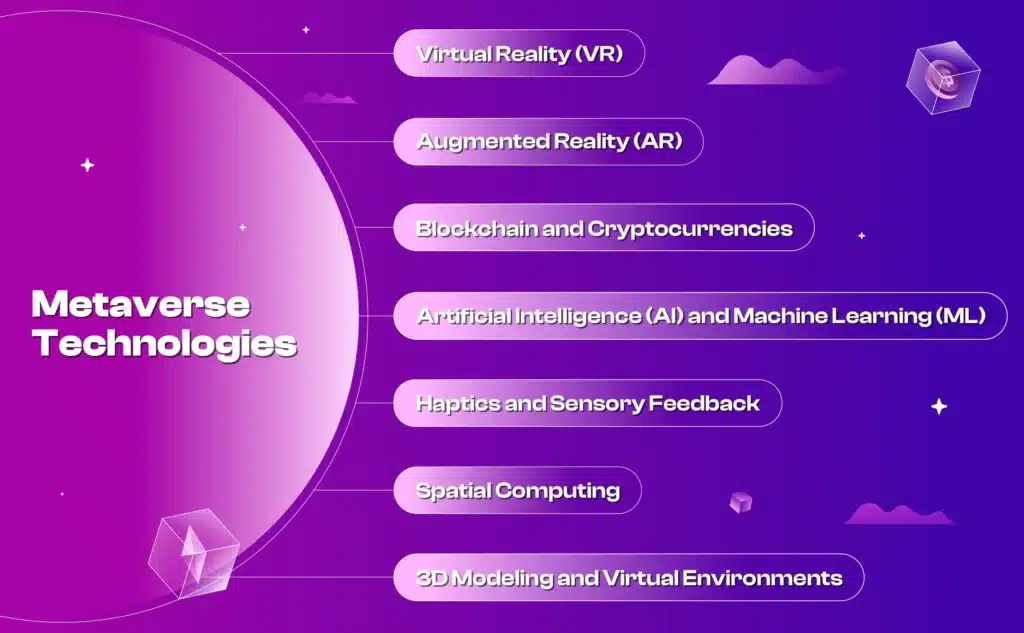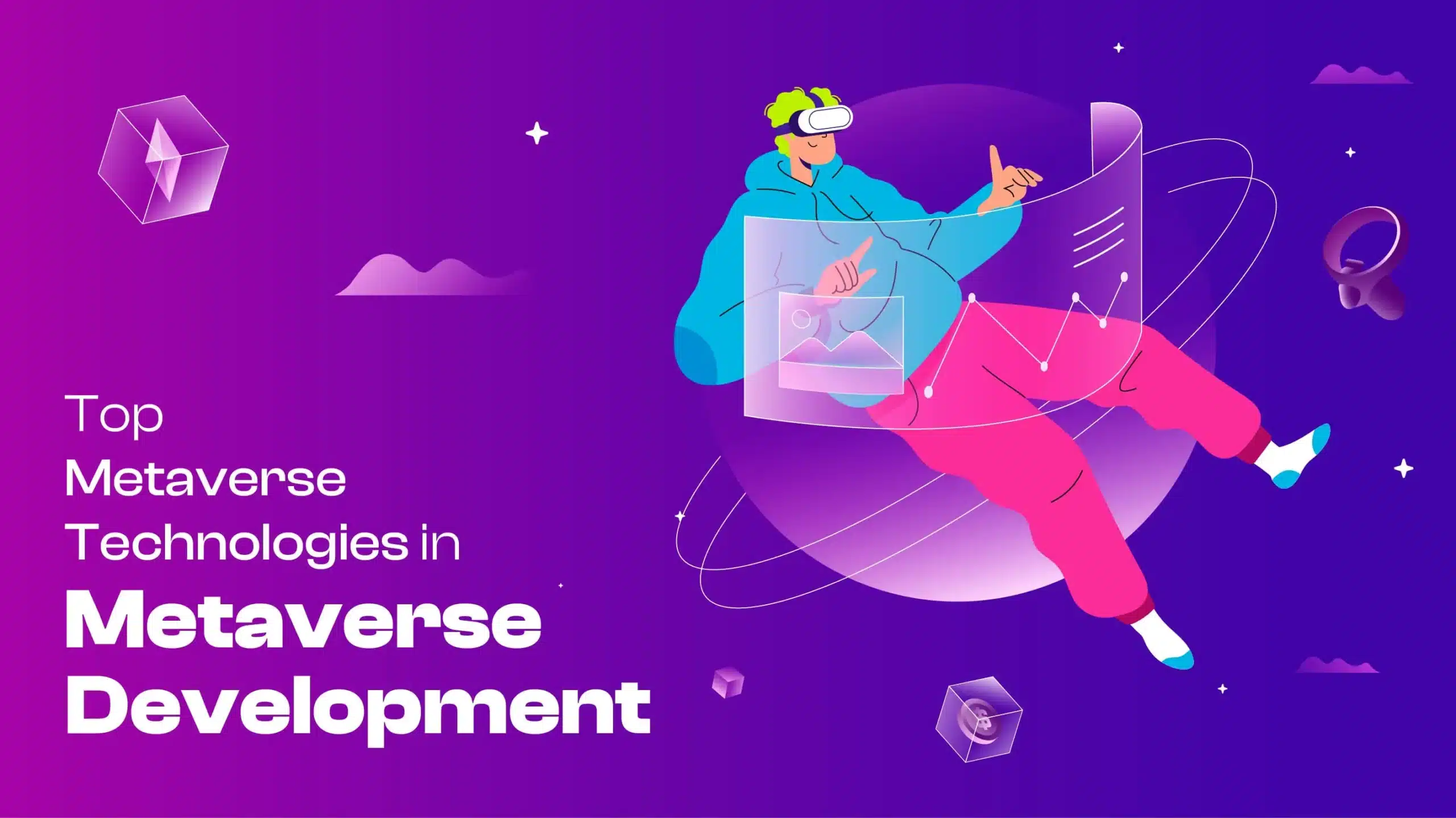Top 7 Metaverse Technologies Shaping Our Virtual Future
- wtsverse
- May 16, 2024
The metaverse term has given technologists, futurists, and enthusiasts something new to think about. It is a digital realm where individuals interact, work, and play in immersive virtual environments. This blog is a brief overview of metaverse development & technologies.
What Is Metaverse Technology?
Metaverse technology has a range of tools, platforms, and protocols which power up virtual environments. User interactions with VR headsets and haptic feedback systems are fiercely in trend today. With blockchain-based economies and AI-driven content generation, these technologies are the building blocks of the metaverse.
Metaverse technologies are what power up the evolution of Virtual reality, augmented reality, and other immersive experiences. They are the seamlessly merged reality of digital and physical worlds – which opens new possibilities for entertainment, education, commerce, and social interaction.
Top 7 Metaverse Technologies in Metaverse Development:

1. Virtual Reality (VR):
Virtual reality immerses users in a simulated environment and replicates sensory experiences. You can wear a VR headset that tracks head movements and displays stereoscopic images. It creates a sense of presence within the virtual world.
From gaming experiences to virtual meetings – the applications of VR are diverse and far-reaching which helps people socialize in virtual environments in real-time.
VR has transformative potential across various industries like gaming, entertainment, healthcare, education, and architecture. It offers new avenues for experiential learning and therapeutic interventions as well as immersive storytelling.
Leading tech companies including meta platforms, HTC Vive, and Sony PlayStation VR continue to drive innovation in VR dynamics. There are innumerable instances of breakthroughs in hardware design, software development, and content creation – which have pushed the boundaries of what’s possible in VR.
2. Augmented Reality (AR):
Augmented Reality overlays digital info into the physical world and enhances real-world experiences. AR blurs the line between digital and physical realms – which enhances the perception of the environment around us. From location-based gaming and interactive advertising to navigation assistance – AR integrates digital content into our surroundings and changes the way we interact. It is one of those metaverse technologies that is more accessible through smartphones and smart glasses – and is prevalent in daily life. From trying on virtual clothing to home decor – AR enhances our daily experiences in novel ways.
AR technology has advanced as a metaverse technology and with improved object recognition, gesture control, and spatial mapping – has evolved in a superb way. Future trends are also gearing up and include wearable AR devices, ubiquitous AR interfaces, and personalized AR experiences.
3. Blockchain and Cryptocurrencies:
Blockchain as one of the excellent metaverse technologies, provides the decentralized infrastructure necessary for building trust, security, and transparency in the metaverse. Through distributed ledgers and smart contracts, blockchain is the creation of virtual economies, digital assets, and secure transactions within virtual environments.
Cryptocurrencies serve as the native currency of the metaverse, facilitating peer-to-peer transactions, virtual asset ownership, and economic interactions within digital worlds. From in-game currencies to non-fungible tokens (NFTs) representing virtual assets, cryptocurrencies play a central role in monetizing virtual experiences.
Cryptocurrencies are the native currency of the metaverse and facilitate peer-to-peer transactions and economic interactions. From in-game currencies to NFTs – people can buy virtual assets and monetize virtual experiences.
These metaverse technologies also have decentralized finance platforms that leverage blockchain technology to offer finance services. People can participate in virtual economies, earn rewards, and engage in decentralized governance within virtual communities.
Though blockchain offers numerous benefits – it has concerns regarding security, privacy, and scalability. You would need robust encryption, identity management, and consensus mechanisms for the integrity and resilience of your virtual environments.
4. Artificial Intelligence (AI) and Machine Learning (ML)
AI and ML technologies enhance the realism, interactivity, and responsiveness of virtual environments in the metaverse. From natural language processing and computer vision to predictive analytics and procedural generation, AI enables intelligent interactions and dynamic content creation within virtual worlds.
AI-driven personalization algorithms tailor virtual experiences to individual preferences, behaviors, and demographics in the metaverse. By analyzing user data and generating personalized recommendations, AI enhances user engagement, retention, and satisfaction across diverse virtual contexts.
AI and ML algorithms automate content creation tasks such as 3D modeling, animation, and texturing in the metaverse. Generative adversarial networks (GANs) and reinforcement learning techniques enable AI to produce lifelike environments, characters, and narratives that enhance immersion and storytelling in virtual worlds.
5. Haptics and Sensory Feedback:
Haptic technology is the sense of touch through tactile feedback, force feedback, and vibration in virtual environments. It has immersion, realism, and present features for providing users with physical sensations to virtual interactions and stimuli.
There are haptic feedback systems such as haptic gloves, vests, and controllers. These enable users to feel and interact with virtual objects in the metaverse. They can convey temperatures, and forces and enrich the sensory experience – deepening the sense of presence within environments.
It is used in gaming, education, and healthcare for training in the metaverse. With smart gameplay mechanics, it facilitates skill acquisition and therapeutic interventions through virtual simulations.
Some frequent high-fidelity actuators, multi-modal feedback, and specialized haptics are in trend along with spatialized haptics for driving innovation in the metaverse. Future trends like full-body haptic suits, haptic holograms, and telepresence systems have physical interaction across virtual distances.
6. Spatial Computing:
Spatial computing combines VR, AR, and IoT technologies for creating immersive, context-aware experiences. As one of the best-supporting metaverse technologies, it enables spatial mapping, object recognition, and environmental understanding. This translates to seamless interaction and navigation in virtual environments.
Spatial computing technologies include simultaneous localization and mapping for real-time mapping and navigation. You can reconstruct physical spaces and overlay digital content while mapping spatial awareness and user mobility with ease.
Spatial computing can do wonders for collaborative workspaces and social interaction in the metaverse. Users can co-create, communicate, and collaborate in virtual environments with such genius applications of metaverse technologies. Virtual meetings and brainstorming sessions become meaningful, and the distance does not matter at all.
Volumetric capture, spatial audio, and gesture recognition are more immersive and interactive as metaverse technologies keep on advancing each day. Hardware, software, and user interfaces push the boundaries of spatial computing, redefining our interaction possibilities.
7. 3D Modeling and Virtual Environments:
3D modeling is the creation of virtual worlds, characters, and assets in the metaverse. From architectural visualization and product design – 3D modeling is the foundation of digital creativity and expression today.
Architectural visualization tools can create interactive representations of buildings and spaces in the metaverse. These tools have architects, designers, and clients wrapped around their fingers, as concepts can be iterated seamlessly, and spaces can be experienced before they are built.
Virtual environments are rich, and interactive and are the best learning experiences for education and training – with the help of these metaverse technologies. From virtual classrooms and training simulations to immersive field trips and historical reconstructions, 3D modeling helps across diverse subjects and disciplines.
Wrapping up with final thoughts on Metaverse Technologies:
The evolution of metaverse technologies is a paradigm shift in how we perceive, interact, and inhabit virtual spaces. By harnessing the power of these metaverse technologies – we are now on a journey of discovery and innovation. These metaverse technologies push the boundaries of imagination and redefine the possibilities of human experience in the digital age.

